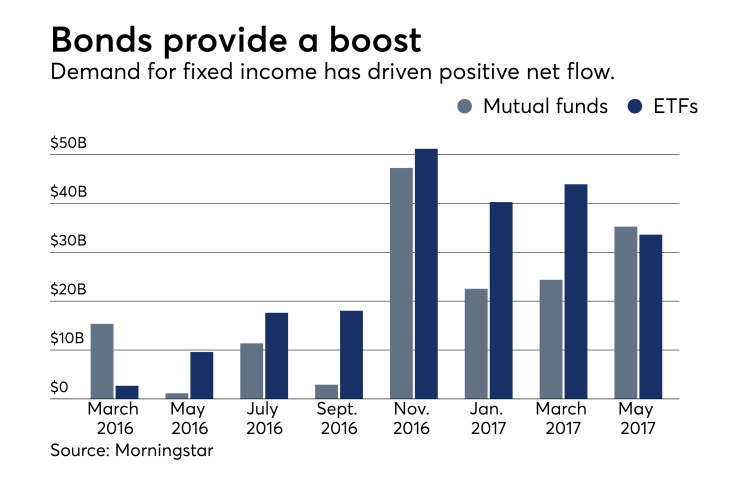U.S. mutual funds outpaced ETFs for the first time since February 2016 by $2.6 billion, according to a study from Cerulli Associates.
Analysts caution that the push may only be temporary driven by the current demand for fixed income.
The monthly net flows for fixed-income U.S. mutual funds remained steady with $29.6 billion for May. In comparison, the net flows for equity U.S. mutual funds was $17.3 billion, according to Morningstar.
The monthly net flows for mutual funds was $35.6 billion for May 2017. For ETFs, the net flows was $33 billion, according to Cerulli Associates.

While mutual funds outpaced ETFs, ETF assets grew 2.2% reaching $2.9 trillion. Mutual fund assets grew 1.7% reaching $13.6 trillion, according to Cerulli Associates.
Taxable bonds had the strongest net flows of $26.5 billion for May. The biggest inflow was at Vanguard with $3.1 billion taking 22.3% of the market share, according to Cerulli Associates.
The desire for fixed-income has driven the demand for mutual funds, even though these funds are expensive, says Morningstar analyst, Alina Lamy.
“While ETF flows have remained strong, mutual fund flows have, indeed, edged higher in recent months, driven by fixed-income demand,” Lamy says.
According to Morningstar, mutual funds started having positive net flows in January and have continued to every month since.
In February 2016, mutual funds had monthly net flows of $9.2 billion and ETFs had $2.7 billion, according to Morningstar.
According to Morningstar, U.S. mutual funds outperformed ETFs by a narrower margin in May than Cerulli Associates reported, only $1.7 billion.
Lamy says that investors should not count on mutual funds to continue to outpace ETFs because there is a lot of growth in the ETF space and that could lead to the growth of fixed-income ETFs.
According to Cerulli Associates, 50% of advisers plan to increase their use of fixed-income ETFs and about 40% of advisers plan to decrease their use of fixed-income mutual funds over the next three years.





